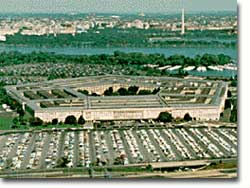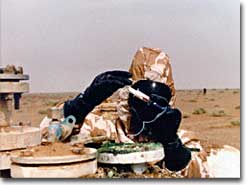11b. Defense Policy

The Pentagon, one of the largest office buildings in the world, houses the Department of Defense and the different branches of the armed forces.
The United States used to have a War Department.
Until 1947 one of the President's cabinet-level positions was the Secretary of War, who headed the War Department. President Harry Truman renamed them the Secretary of Defense" and the Department of Defense, a telltale sign of changing times. The most destructive war of modern times — World War II — had ended only two years before, and nuclear weapons were introduced at its conclusion. The hope was that countries would "beat their swords into plowshares," according to the famous biblical statement that was to be engraved into a wall of the United Nations building in New York City. Still, a United States defense policy is necessary as a second level of protection in case diplomacy fails to solve international problems.
Who Makes Defense Policy?

UN economic sanctions have been in effect in Iraq since the end of the Gulf War. Iraqis regard then U.S. President George Bush as a criminal who has brought suffering to the innocent civilian population.
The President takes the lead in defense policy. This initiative is based on the constitutional powers as "Commander in Chief" of the armed forces. The Constitution grants Congress the power to declare war, a power with much less meaning in today's world. The last time that the United States officially declared war was December 8, 1941, the day after the Japanese attacked Pearl Harbor. Yet America has fought full-scale wars in Korea, Vietnam, and the Persian Gulf without actually declaring war.
Today the President is able to order covert — or secret — operations to avoid full-scale military involvement. If that option fails, the President, sometimes with the vote of Congress, can try coercion, or tactics that force countries to "behave." Examples are economic boycotts, breaking diplomatic relations, and restricting tourist and business travel between countries. The United States has applied all of these tactics to Cuba since Communist leader Fidel Castro took over in 1959. The President may also avoid congressional involvement in decision-making by endorsing limited military "interventions" without asking for a war declaration.
The Department of Defense is the President's main source of advice on military policy. Its headquarters is the Pentagon, which houses about 25,000 military and civilian personnel. True to the wishes of the founders, the Secretary of Defense — who heads the department — is always a civilian. However, all three military departments — the Army, the Navy, and the Air Force — are under the general supervision of the Secretary of Defense.
The Joint Chiefs of Staff is a five-member advisory body to the President, the National Security Council, and the Secretary of Defense. It includes the Chiefs of Staff of the three military departments and the commandant of the Marines. The President, with the consent of the Senate appoints all of the service chiefs, as well as the chair.
Threats to National Security
In a 1993 review of the mission and needs of the Defense Department, Secretary of Defense Les Aspin identified four major threats to U.S. national security:
- The rapid growth of weapons of mass destruction, such as nuclear bombs
- Regional conflicts in the Middle East, Korea, and elsewhere
- The emergence of anti-democratic forces in Russia
- The erosion of American economic strength

Even though the United States economy is considerably stronger than it was in 1993, all four threats remain important today. Since the Cold War ended in the early 1990s, Defense Department expenditures have come under closer scrutiny, with many people demanding that less be spent for defense programs. However, the Defense Department concluded that the United States needs sufficient military forces to conduct military operations against two "rogue nations" — such as Iraq, Iran, Libya, and North Korea — at the same time. The Department also sees a number of other states, such as China or India, as potential problem states.
Just as developing a coherent foreign policy is problematic in these post-Cold War days, so is the question of defending the country against possible danger from outside its borders. The avoidance of war, as indicated by the 1947 name change from "Department of War" to "Department of Defense" today holds the highest priority, and the hope that the United States can play a role in limiting violent upheavals around the world is reflected in both its foreign and military policies.







